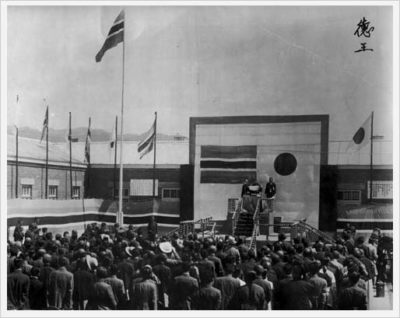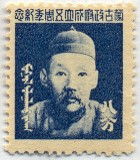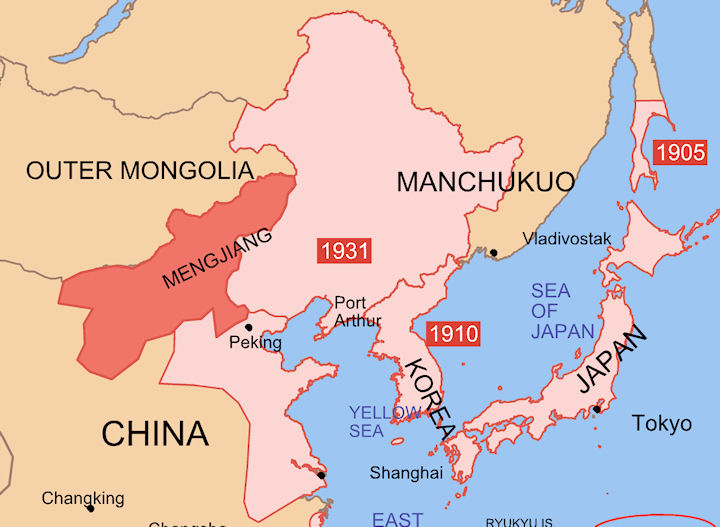ALBUM – view my Mengjiang album
Fast Facts
Region: China Area
Group: Japanese Puppet States and Occupations
Classification: Puppet State (Japan)
Prior Regime: Republic of China
Key Dates:
1935 – 1936 – Japanese invade Inner Mongolia
1936, May 12 – Mongolian Military Government Established
1937, Dec 8 – Mengjiang was officially formed.
1941, Aug 4 – Mongolian Autonomous Federation established as a semi-autonomous state.
1945, Aug 19 – Soviets capture Mengjiang shortly after the surrender of the Japanese.
Following Regime: Soviet Occupation of Mengjiang
Scott Catalogue: (China) 2N1-2N127
History

Japan continued to expand in Manchuria and Inner Mongolia until full scale war broke out with the Chinese in July of 1937. Needing to shore up the north, on Dec 8, 1937, Prince Demchugdongrub, who was now known as Prince De Wang, changed the name of the regime to Mengjiang (Mengkukuo in Japanese) and established its capital in Kalgan. Shortly afterwords, the Chinese delegate in the region was murdered and the Japanese imposed a government on Mengjiang in which all of the principle minsters of the government were Japanese. As the war with the Chinese continued, additional regions were added, expanding the borders of Mengjiang.
In 1941, Mengjiang was officially declared the semi-autonomous nation of the Mongolian Autonomous Federation, allied with the Empire of Manchukuo. This lasted throughout the war until Mengjiang collapsed and was taken by Soviet troops on August 19, 1945, shortly after the surrender of Japan in WW2. Demchugdongrub lived in Beijing, but fled to Mongolia when the Communists took control of China. He was captured by the Soviets and returned to China and imprisoned in 1949. He was pardoned in 1963, three years prior to his death.
Stamps
 ALBUM
ALBUM
For the initial occupation period, Mengjiang, as well as most of North China, Japanese postal authorities continued to use existing Chinese stamps for postage. However, in 1941, as the currency of China was suffering severe deflation, hordes of stamps were being smuggled from the south for resale in Japanese occupied areas. To prevent the practice, the Japanese began overprinting a control mark on stamps with the name of the various provinces. For Mengjiang, the stamps were overprinted “疆 蒙” on the upper third of the stamp. Specialists identify two different types of the early overprints.
Chinese stamps from various series were overprinted, making it challenging, but interesting to accumulate. Beginning in 1942, as rapid inflation began setting in the region, postal authorities began surcharging the stamps with increasingly higher values. Chinese stamps with the surcharge continued use in Mengjiang until end of the war.
In addition, unlike other regions in North China, commemorative stamps were printed and issued in Mengjiang by the Japanese. Four different sets were issued:
- In 1943, the Japanese issued two stamps with dragon carved on a pillar surrounded by doves to commemorate the fifth Anniversary of the Inner Mongolia Post and Telegraph Service.
- In 1943, the Japanese issued two stamps depicting coal miners to commemorate the second anniversary of the Greater East Asia War (which began with the attack on Pearl Harbor).
- In 1944, the Japanese issued two stamps with different designs celebrating the fifth anniversary of the founding of the Federal Autonomous Government of Mongolia (Mengjiang). One stamp depicted a beautiful stylized drawing of a flying horse and the other a portrait of De Wang, the chairman of Mengjiang.
- On Dec 8, 1944, the Japanese issued a single stamp of an industrial plant to commemorate the third anniversary of the Greater East Asia War.
Links
The Puppet Masters – How Japan’s Military Established a Vassal State in Inner Mongolia from Military History Now
Mengjiang at GlobalSecurity.org
Mengjiang Discussion at Stamporama
Mengjiang Discussion at Stamp Boards





